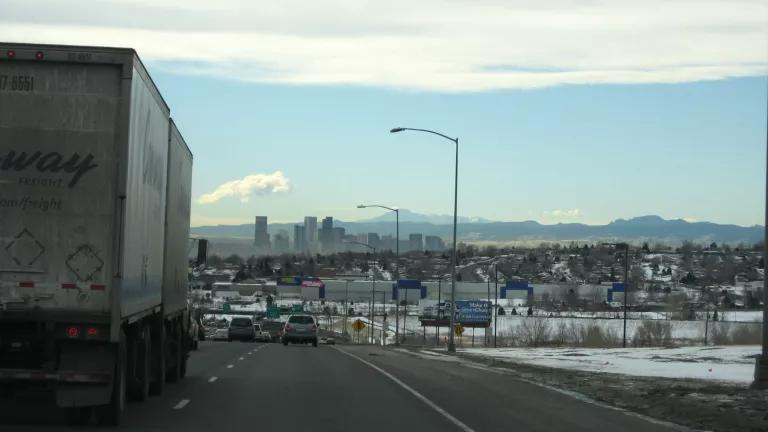Fighting Oil Addiction
Ranking states' gasoline price vulnerability and solutions for change
November 2012
Energy policy and prices remain front and center in the American consciousness, particularly as national election consequences play out and the fragile economy continues to make many Americans feel more vulnerable. Americans continued to feel the painful pinch of gasoline prices in 2011 -- and they still do today. To curb America's perilous oil addiction, we continue to need effective government policies that will increase the availability and use of efficient vehicles and clean fuels, as well as promote smart growth and public transit.
This is the 6th edition of this report by David Gardiner & Associates (DGA) and the Natural Resources Defense Council (NRDC), identifying the states whose citizens feel the greatest economic pain from gasoline prices -- and the states that are doing the most to break their addiction to oil. Like the previous editions, this report again ranks U.S. states in two critical areas related to our nation's continuing addiction to oil.
First, it calculates gasoline price vulnerability -- the percentage of personal income spent on gasoline by the average driver in each state. Second, it ranks states based on their adoption of smart solutions to reduce their oil dependence -- measures they are taking to strategically lessen their vulnerability and to bolster America's security.
The data yield some clear conclusions:
- Oil dependence affects all states, but some states' drivers are hit harder economically than others. Drivers in every state in 2011 spent a higher percentage of their income on gasoline than they did in 2010, and drivers in the most vulnerable states spent more than twice as large a percentage of their income on gasoline as drivers in the least vulnerable states.
- Drivers in most states (42) were hit even harder in 2011 than they were during the previous heights of vulnerability in 2008.
- While some states are pioneering solutions and many are taking some action, many states are still taking few, if any, of the steps listed in this report to reduce their oil dependence.
Solutions to reducing consumer gasoline bills do exist, but not without help from both state and federal governments. Each state needs to adopt measures that promote efficient vehicles, smart growth, and transit, while the federal government must provide effective policies that reduce oil dependence in the United States through delivering more clean vehicle, fuel, and transportation options to consumers who deserve no less.
May 2011
Unrest in the Middle East has raised concerns about how dependent the United States is on foreign oil. The price of gasoline has been skyrocketing. And the recession has continued to make many Americans feel more economically vulnerable. Americans continued to feel the painful pinch of gasoline prices in 2010 – and they still do today.
This report updates the Natural Resources Defense Council’s (NRDC) 2007, 2008, 2009, and 2010 research identifying the states whose citizens feel the greatest economic pain from gasoline prices — and those states that are doing the most to break their addiction to oil. Like the previous editions, this report again ranks U.S. states in two critical areas related to our nation’s continuing addiction to oil.
First, it calculates gasoline price vulnerability – how heavily each state’s drivers are affected by increases in gasoline prices. Second, it ranks states based on their adoption of solutions to reduce their oil dependence – measures they are taking to lessen their vulnerability and to bolster America’s security.
The data yield some clear conclusions:
- Oil dependence affects all states, but some states' drivers are hit harder economically than others. Drivers in almost every state in 2010 spent a higher percentage of their income on gasoline than they did in 2009, and drivers in the most vulnerable states spent more than twice as large a percentage of their income on gasoline as drivers in the least vulnerable states.
- Drivers are being hit even harder right now than they were in 2010.
- While some states are pioneering solutions and many are taking some action, many states are still taking few (if any) of the steps listed in this report to reduce their oil dependence.
To curb America’s perilous oil addiction, we need effective government policies that will increase the availability and use of efficient vehicles and clean fuels, as well as promote smart growth and public transit.
November 2010
The events of 2010 have made clear the perils of our dependence on oil. The continued recession has stretched the resources of many Americans and underscored the need for affordable transportation. The massive oil spill in the Gulf of Mexico has poignantly reminded us of both the environmental and economic costs associated with our nation’s addiction to oil.
America's addiction to oil continues to threaten not only our national security and global environmental health, but also our economic viability. NRDC analyzed how heavily drivers in each state are affected by oil prices and ranked states on their adoption of solutions to reduce their oil dependence -- measures they are taking to lessen their vulnerability and to bolster America's security. NRDC found that gas prices, combined with the economic downturn, are making people more vulnerable to changes in oil prices. But many states are taking significant steps to reduce oil dependence through smart clean-transportation policies.
Our analysis shows that:
- Oil dependence affects all states, but some drivers are hit harder economically than others.
- Drivers in 2009 spent a markedly lower percentage of their income on gasoline than they did in 2008, and drivers in all but 5 states actually spent a lower percentage than they did in 2006. This is a notable change in the trend of the past few years, which saw increasing vulnerability.
- While some states are pioneering solutions and many are taking some action, a fair number of states are still taking few (if any) of the steps needed to reduce their oil dependence.
By promoting clean vehicle and fuel technologies as well as transportation alternatives, states can reduce oil dependence. These measures can, in turn, create clean energy jobs, reduce vulnerability to fuel price hikes, and lessen air pollution and greenhouse gas emissions.
August 2009
America's addiction to oil continues to threaten not only our national security and global environmental health, but also our economic viability. NRDC analyzed how heavily drivers in each state are affected by increases in oil prices and ranked states on their adoption of solutions to reduce their oil dependence -- measures they are taking to lessen their vulnerability and to bolster America's security. NRDC found that rising gas prices, combined with the economic downturn, are making people more vulnerable to changes in oil prices. But many states are taking significant steps to reduce oil dependence through smart clean-transportation policies.
Our analysis shows that:
- Oil dependence affects all states, but some drivers are hit harder economically than others.
- The trends in states' vulnerability to oil price increases over the past couple of years are not encouraging -- drivers in every state were more vulnerable in 2008 than they were in 2006.
- While some states are pioneering solutions and many are taking some action, a fair number of states are still taking few (if any) of the steps needed to reduce their oil dependence.
By promoting clean vehicle and fuel technologies as well as transportation alternatives, states can reduce oil dependence. These measures can, in turn, create clean energy jobs, reduce vulnerability to fuel price hikes, and lessen air pollution and greenhouse gas emissions.
July 2008
The sharp rise in gas prices has been a reminder that America's addiction to oil continues to threaten our economic viability, our national security and global environmental health. To curb this perilous addiction, we need effective government policies that will increase the availability and use of efficient vehicles and clean fuels and that will promote smart growth and public transit. This July 2008 issue paper identifies the states that are most vulnerable to spikes in oil prices?and those states that are doing the most to break their addiction to oil.



